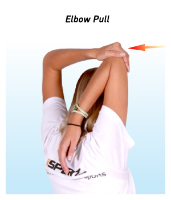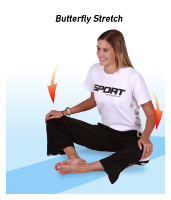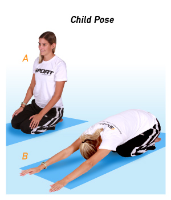Stretches for Swimming
August 20, 2024

Swimming engages almost every muscle in your body, making it a highly effective workout. However, to prevent injury and enhance performance, incorporating a proper stretching routine before and after your swim is crucial. This guide will walk you through essential stretches for your arms, back, and legs, helping you stay flexible and reduce the risk of strain. For each stretch, hold the position for 30 seconds and repeat on both sides to ensure a thorough warm-up or cool-down.
Arms & Shoulders: Prepping for Power
Your arms and shoulders do the heavy lifting in every swimming stroke. Stretching these areas effectively is key to maintaining flexibility and avoiding injury.
Elbow Pull Stretch
Target Muscles: Triceps, lats, and shoulder muscles around the armpit.
How to Perform:
 1. Start by placing your right hand behind your head, with your elbow pointing straight up.
1. Start by placing your right hand behind your head, with your elbow pointing straight up.
2. Use your left hand to gently pull your right elbow inward.
3. Hold this position for 30 seconds to stretch the muscles, then switch arms and repeat.
Wall Press Stretch
Target Muscles: Front of the shoulder.
How to Perform:
 1. Stand near a wall and place your right hand on it at shoulder height, with your thumb facing upward.
1. Stand near a wall and place your right hand on it at shoulder height, with your thumb facing upward.
2. Slightly bend your right elbow.
3. Twist your body to the left, moving away from the wall.
4. Hold this position to stretch the front of your shoulder, then switch arms and repeat.
Legs & Glutes: Powering Your Kick
Your legs and glutes are vital for propulsion in the water. Proper stretching will keep these muscles loose and ready for action.
Wall Lean Stretch
Target Muscles: Calves.
How to Perform:
 1. Place your hands on a wall at shoulder height, keeping them shoulder-width apart.
1. Place your hands on a wall at shoulder height, keeping them shoulder-width apart.
2. Lean into the wall while stepping your right foot back as far as comfortable, ensuring your right heel stays on the ground.
3. Keep your right leg straight and hold the stretch for 30 seconds. Then switch legs and repeat.
Pretzel Stretch
Target Muscles: Glutes.
How to Perform:
 1. Sit on the ground and bend your right leg, placing your foot flat on the floor.
1. Sit on the ground and bend your right leg, placing your foot flat on the floor.
2. Lift your left leg and place your left ankle on your right thigh.
3. Gently push your left knee away from you. If you need a deeper stretch, move your right foot closer to your glutes.
4. Hold this position for 30 seconds, then switch legs and repeat.
Butterfly Stretch
Target Muscles: Inner thighs and groin.
How to Perform:
 1. Sit on the floor with your back straight.
1. Sit on the floor with your back straight.
2. Bend your knees and bring the soles of your feet together.
3. Hold your feet with your hands and press your knees toward the floor for a deeper stretch.
4. Hold for 30 seconds to effectively stretch the inner thighs.
Back: Maintaining Flexibility in Every Stroke
Swimming strokes like freestyle and backstroke require constant rotation, engaging your lateral and lower back muscles. These stretches will help you maintain flexibility and prevent tightness.
Model Pose Stretch
Target Muscles: Laterals.
How to Perform:
 1. Sit on the floor with your left leg bent and your left foot flat on the ground.
1. Sit on the floor with your left leg bent and your left foot flat on the ground.
2. Straighten your right leg.
3. Cross your left foot over your right leg.
4. Press your right elbow against the outside of your left leg as you twist your torso to the left.
5. Hold this position for 30 seconds, then switch sides and repeat.
Child’s Pose Stretch
Target Muscles: Lower back and hips.
How to Perform:
 1. Kneel on the floor with your shins and feet flat against the ground.
1. Kneel on the floor with your shins and feet flat against the ground.
2. Touch your legs together and rest your thighs on your calves.
3. Lean forward, bringing your belly to your thighs and resting your forehead on the floor.
4. Stretch your arms out in front of you with your palms facing down.
5. Hold this position for 30 seconds, focusing on deep breathing to relax your lower back and hips.
Post-Practice Stretching: The Importance of Cool-Down
While stretching before a workout is important, post-swim stretching is even more crucial. After your swim, take a few minutes to stretch your muscles. This cool-down period helps loosen tight muscles, aids in recovery, and prepares your body for the next session. Incorporating these stretches into your routine will help you feel more flexible and ready for your next practice.
By following this guide, you can maintain your flexibility, reduce the risk of injury, and enhance your overall swimming performance. Make stretching an integral part of your swimming routine in 2024, and you’ll notice the benefits both in and out of the water.



